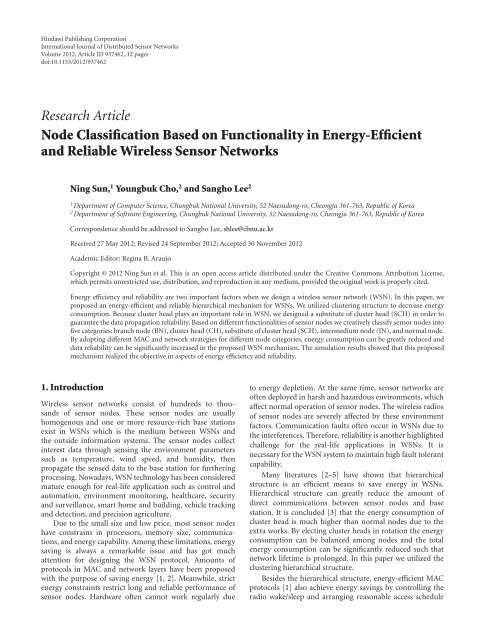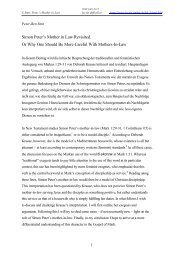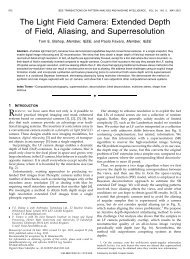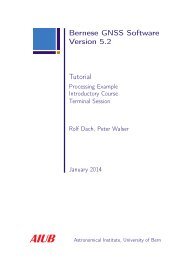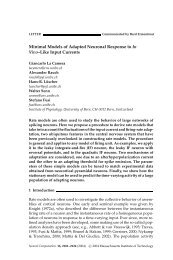Deploying Real-Life WSN Applications: Challenges ... - IAM - CDS
Deploying Real-Life WSN Applications: Challenges ... - IAM - CDS
Deploying Real-Life WSN Applications: Challenges ... - IAM - CDS
You also want an ePaper? Increase the reach of your titles
YUMPU automatically turns print PDFs into web optimized ePapers that Google loves.
Hindawi Publishing Corporation<br />
International Journal of Distributed Sensor Networks<br />
Volume 2012, Article ID 937462, 12 pages<br />
doi:10.1155/2012/937462<br />
Research Article<br />
Node Classification Based on Functionality in Energy-Efficient<br />
and Reliable Wireless Sensor Networks<br />
Ning Sun, 1 Youngbuk Cho, 2 and Sangho Lee 2<br />
1<br />
Department of Computer Science, Chungbuk National University, 52 Naesudong-ro, Cheongju 361-763, Republic of Korea<br />
2<br />
Department of Software Engineering, Chungbuk National University, 52 Naesudong-ro, Cheongju 361-763, Republic of Korea<br />
Correspondence should be addressed to Sangho Lee, shlee@cbnu.ac.kr<br />
Received 27 May 2012; Revised 24 September 2012; Accepted 30 November 2012<br />
Academic Editor: Regina B. Araujo<br />
Copyright © 2012 Ning Sun et al. This is an open access article distributed under the Creative Commons Attribution License,<br />
which permits unrestricted use, distribution, and reproduction in any medium, provided the original work is properly cited.<br />
Energy efficiency and reliability are two important factors when we design a wireless sensor network (<strong>WSN</strong>). In this paper, we<br />
proposed an energy-efficient and reliable hierarchical mechanism for <strong>WSN</strong>s. We utilized clustering structure to decrease energy<br />
consumption. Because cluster head plays an important role in <strong>WSN</strong>, we designed a substitute of cluster head (SCH) in order to<br />
guarantee the data propagation reliability. Based on different functionalities of sensor nodes we creatively classify sensor nodes into<br />
five categories: branch node (BN), cluster head (CH), substitute of cluster head (SCH), intermedium node (IN), and normal node.<br />
By adopting different MAC and network strategies for different node categories, energy consumption can be greatly reduced and<br />
data reliability can be significantly increased in the proposed <strong>WSN</strong> mechanism. The simulation results showed that this proposed<br />
mechanism realized the objective in aspects of energy efficiency and reliability.<br />
1. Introduction<br />
Wireless sensor networks consist of hundreds to thousands<br />
of sensor nodes. These sensor nodes are usually<br />
homogenous and one or more resource-rich base stations<br />
exist in <strong>WSN</strong>s which is the medium between <strong>WSN</strong>s and<br />
the outside information systems. The sensor nodes collect<br />
interest data through sensing the environment parameters<br />
such as temperature, wind speed, and humidity, then<br />
propagate the sensed data to the base station for furthering<br />
processing. Nowadays, <strong>WSN</strong> technology has been considered<br />
mature enough for real-life application such as control and<br />
automation, environment monitoring, healthcare, security<br />
and surveillance, smart home and building, vehicle tracking<br />
and detection, and precision agriculture.<br />
Due to the small size and low price, most sensor nodes<br />
have constrains in processors, memory size, communications,<br />
and energy capability. Among these limitations, energy<br />
saving is always a remarkable issue and has got much<br />
attention for designing the <strong>WSN</strong> protocol. Amounts of<br />
protocols in MAC and network layers have been proposed<br />
with the purpose of saving energy [1, 2]. Meanwhile, strict<br />
energy constraints restrict long and reliable performance of<br />
sensor nodes. Hardware often cannot work regularly due<br />
to energy depletion. At the same time, sensor networks are<br />
often deployed in harsh and hazardous environments, which<br />
affect normal operation of sensor nodes. The wireless radios<br />
of sensor nodes are severely affected by these environment<br />
factors. Communication faults often occur in <strong>WSN</strong>s due to<br />
the interferences. Therefore, reliability is another highlighted<br />
challenge for the real-life applications in <strong>WSN</strong>s. It is<br />
necessary for the <strong>WSN</strong> system to maintain high fault tolerant<br />
capability.<br />
Many literatures [2–5] have shown that hierarchical<br />
structure is an efficient means to save energy in <strong>WSN</strong>s.<br />
Hierarchical structure can greatly reduce the amount of<br />
direct communications between sensor nodes and base<br />
station. It is concluded [3] that the energy consumption of<br />
cluster head is much higher than normal nodes due to the<br />
extra works. By electing cluster heads in rotation the energy<br />
consumption can be balanced among nodes and the total<br />
energy consumption can be significantly reduced such that<br />
network lifetime is prolonged. In this paper we utilized the<br />
clustering hierarchical structure.<br />
Besides the hierarchical structure, energy-efficient MAC<br />
protocols [1] also achieve energy savings by controlling the<br />
radio wake/sleep and arranging reasonable access schedule


